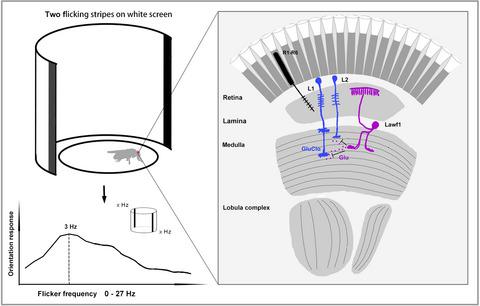当前位置:
X-MOL 学术
›
J. Neurochem.
›
论文详情
Our official English website, www.x-mol.net, welcomes your feedback! (Note: you will need to create a separate account there.)
Lamina feedback neurons regulate the bandpass property of the flicker-induced orientation response in Drosophila.
Journal of Neurochemistry ( IF 4.7 ) Pub Date : 2020-05-08 , DOI: 10.1111/jnc.15036 Deliang Yuan 1, 2 , Xiaoxiao Ji 1, 2 , Shun Hao 1, 2 , Julia Yvonne Gestrich 1 , Wenlan Duan 1, 2 , Xinwei Wang 1, 2 , Yuanhang Xiang 1, 2 , Jihua Yang 1, 2 , Pengbo Hu 1, 2 , Mengbo Xu 1 , Li Liu 1, 2, 3 , Hongying Wei 1, 2
Journal of Neurochemistry ( IF 4.7 ) Pub Date : 2020-05-08 , DOI: 10.1111/jnc.15036 Deliang Yuan 1, 2 , Xiaoxiao Ji 1, 2 , Shun Hao 1, 2 , Julia Yvonne Gestrich 1 , Wenlan Duan 1, 2 , Xinwei Wang 1, 2 , Yuanhang Xiang 1, 2 , Jihua Yang 1, 2 , Pengbo Hu 1, 2 , Mengbo Xu 1 , Li Liu 1, 2, 3 , Hongying Wei 1, 2
Affiliation

|
Natural scenes contain complex visual cues with specific features, including color, motion, flicker, and position. It is critical to understand how different visual features are processed at the early stages of visual perception to elicit appropriate cellular responses, and even behavioral output. Here, we studied the visual orientation response induced by flickering stripes in a novel behavioral paradigm in Drosophila melanogaster. We found that free walking flies exhibited bandpass orientation response to flickering stripes of different frequencies. The most sensitive frequency spectrum was confined to low frequencies of 2–4 Hz. Through genetic silencing, we showed that lamina L1 and L2 neurons, which receive visual inputs from R1 to R6 neurons, were the main components in mediating flicker‐induced orientation behavior. Moreover, specific blocking of different types of lamina feedback neurons Lawf1, Lawf2, C2, C3, and T1 modulated orientation responses to flickering stripes of particular frequencies, suggesting that bandpass orientation response was generated through cooperative modulation of lamina feedback neurons. Furthermore, we found that lamina feedback neurons Lawf1 were glutamatergic. Thermal activation of Lawf1 neurons could suppress neural activities in L1 and L2 neurons, which could be blocked by the glutamate‐gated chloride channel inhibitor picrotoxin (PTX). In summary, lamina monopolar neurons L1 and L2 are the primary components in mediating flicker‐induced orientation response. Meanwhile, lamina feedback neurons cooperatively modulate the orientation response in a frequency‐dependent way, which might be achieved through modulating neural activities of L1 and L2 neurons.
中文翻译:

层反馈神经元调节果蝇闪烁诱导的定向反应的带通特性。
自然场景包含具有特定功能的复杂视觉线索,包括颜色,运动,闪烁和位置。至关重要的是要了解在视觉感知的早期如何处理不同的视觉特征,以引起适当的细胞反应,甚至行为输出。在这里,我们研究了果蝇的一种新的行为范式中的闪烁条纹引起的视觉定向反应。。我们发现自由行走的苍蝇表现出对不同频率的闪烁条纹的带通取向响应。最敏感的频谱仅限于2-4 Hz的低频范围。通过基因沉默,我们发现接收R1到R6神经元视觉输入的L1和L2层神经元是介导闪烁诱导的定向行为的主要成分。此外,不同类型的薄片反馈神经元Lawf1,Lawf2,C2,C3和T1对特定频率的闪烁条纹的定向响应进行了特定的阻滞,这表明带通取向响应是通过对薄片反馈神经元的协同调制而产生的。此外,我们发现椎板反馈神经元Lawf1具有谷氨酸能。Lawf1神经元的热激活可以抑制L1和L2神经元的神经活动,这可能被谷氨酸盐酸盐氯化物通道抑制剂微毒素(PTX)阻断。总之,层状单极神经元L1和L2是介导闪烁诱导的定向反应的主要成分。同时,层板反馈神经元以频率依赖的方式协同调节定向反应,这可以通过调节L1和L2神经元的神经活动来实现。
更新日期:2020-05-08
中文翻译:

层反馈神经元调节果蝇闪烁诱导的定向反应的带通特性。
自然场景包含具有特定功能的复杂视觉线索,包括颜色,运动,闪烁和位置。至关重要的是要了解在视觉感知的早期如何处理不同的视觉特征,以引起适当的细胞反应,甚至行为输出。在这里,我们研究了果蝇的一种新的行为范式中的闪烁条纹引起的视觉定向反应。。我们发现自由行走的苍蝇表现出对不同频率的闪烁条纹的带通取向响应。最敏感的频谱仅限于2-4 Hz的低频范围。通过基因沉默,我们发现接收R1到R6神经元视觉输入的L1和L2层神经元是介导闪烁诱导的定向行为的主要成分。此外,不同类型的薄片反馈神经元Lawf1,Lawf2,C2,C3和T1对特定频率的闪烁条纹的定向响应进行了特定的阻滞,这表明带通取向响应是通过对薄片反馈神经元的协同调制而产生的。此外,我们发现椎板反馈神经元Lawf1具有谷氨酸能。Lawf1神经元的热激活可以抑制L1和L2神经元的神经活动,这可能被谷氨酸盐酸盐氯化物通道抑制剂微毒素(PTX)阻断。总之,层状单极神经元L1和L2是介导闪烁诱导的定向反应的主要成分。同时,层板反馈神经元以频率依赖的方式协同调节定向反应,这可以通过调节L1和L2神经元的神经活动来实现。



























 京公网安备 11010802027423号
京公网安备 11010802027423号